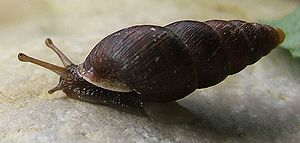Ena (genus)
| Ena | ||||||||||||
|---|---|---|---|---|---|---|---|---|---|---|---|---|

Mountain wolverine snail ( Ena montana ) |
||||||||||||
| Systematics | ||||||||||||
|
||||||||||||
| Scientific name | ||||||||||||
| Ena | ||||||||||||
| Turton , 1831 |
Ena is the eponymous genus of the Enidae family ( wolverine snails ) from the subordination of land snails (Stylommatophora).
features
The conical to ovoid-conical housings are 13 to 17 mm high and 5 to 6.5 mm wide. They have seven to eight turns, which are moderately curved on the periphery. The last turn only rises slightly, if at all, just before the mouth. The ovoid to elongated ovoid mouth is unreinforced. The mouth is slightly inclined to the longitudinal axis of the housing. The edge of the mouth is only slightly bent outwards and only slightly thickened. The navel is a long, wide slit. The color of the case varies from horn-colored to chestnut brown. The surface shows a clear streaking of growth. The shell is comparatively strong.
In the reproductive system, the spermatic duct (vas deferens) branches off from the egg duct (spermoviduct). He is very long and thin. It opens into the very long epiphallus a little below the apex ; the apex of the epiphallus is drawn out into a short, conical flagellum. A short conical blind sack (epiphallus blind sack or epiphallus caecum) sits approximately in the middle of the total length of the epiphallus. The thickness of the epiphallus varies little over its entire extent. The epiphallus / penis transition is marked by an increase to twice the thickness of the epiphallus. The penis is very short compared to the epiphallus. The very long penis appendix starts in the lower half of the penis and can be divided into five sections of different thickness. The lower part is a little as thick as the penis itself. This is followed by a very short part that is about half the thickness of the first part. Then the thickness decreases again significantly. The fourth section is a little thinner and gradually goes into the end part, which is elongated-club-shaped. The retractor muscle splits into two strands, one of which attaches to the penis, the other strand to the lower, strongly thickened part of the penile appendix. In the female genital tract, the free fallopian tube is very long and the vagina is very short. The seminal vesicle sits on a long stem. Just before the small elongated bladder, a very long diverticulum branches off, reaching approximately two-thirds the length of the pedicle.
Geographical distribution
The representatives of the genus Ena are restricted to Europe, Asia Minor and the Middle East.
Taxonomy
The taxon was established by William Turton in 1831 . The genus is now generally recognized as an independent genus and is the type genus of the Enidae family.
-
Ena Turton, 1831
- Ena concolor (Westerlund, 1887)
- Ena dazimonensis Hausdorf, 2001
- Ena elongata (Kobelt, 1877)
- Ena menkhorsti Hausdorf & Bank, 2001
- Mountain wolverine snail ( Ena montana (Draparnaud, 1801))
- Ena monticola (Roth, 1856)
- Ena nogellii (Roth, 1850)
- † Ena sharmani (Baily, 1858), Sarmatian , Miocene
- † Ena stefanii Wenz, 1919, Pontium , Pliocene
- Ena subtilis (Rossmässler, 1837)
supporting documents
literature
- Edmund Gittenberger: The Enidae (Gastropoda, Pulmonata) collected from the Dutch biological expedition to Turkey in 1959. Zoologische Mededelingen, 42: 125–141, Leiden 1967 PDF
- Burçin Aşkım Gümüş, Eike Neubert: New taxa of terrestrial molluscs from Turkey (Gastropoda, Pristilomatidae, Enidae, Hygromiidae, Helicidae). ZooKeys, 171: 17-37, 2012 doi : 10.3897 / zookeys.171.2273
- Bernhard Hausdorf: The genus Ena in Turkey, with remarks on its phylogenetic relationships (Gastropoda: Buliminidae). Journal of Natural History, 35 (11): 1627-1638, 2001 doi : 10.1080 / 002229301317092360
- Anatolij A. Schileyko: Treatise on Recent Terrestrial Pulmonate Molluscs. Part 2. Gastrocoptidae, Hypselostomatidae, Vertiginidae, Truncatellinidae, Pachnodidae, Enidae, Sagdidae. Ruthenica, Supplement 2 (2): 129-261, Moscow 1998 ISSN 0136-0027
- Francisco W. Welter-Schultes: European non-marine molluscs, a guide for species identification = identification book for European land and freshwater mollusks. A1-A3 p., 679 p., Q1-Q78 p., Planet Poster Ed., Göttingen 2012, ISBN 3-933922-75-5 , ISBN 978-3-933922-75-5 (p. 132)
Individual evidence
- ↑ Turton, W. 1831. A manual of the land and freshwater shells of the British Islands arranged according to the more modern systems of classification; and described from perfect specimens in the author's cabinet: with colored plates of every species. - pp. i-viii [= 1-8], 1-152, Pl. [1-10]. London. (Longman etc.) Online at www.biodiversitylibrary.org (p. 80).
